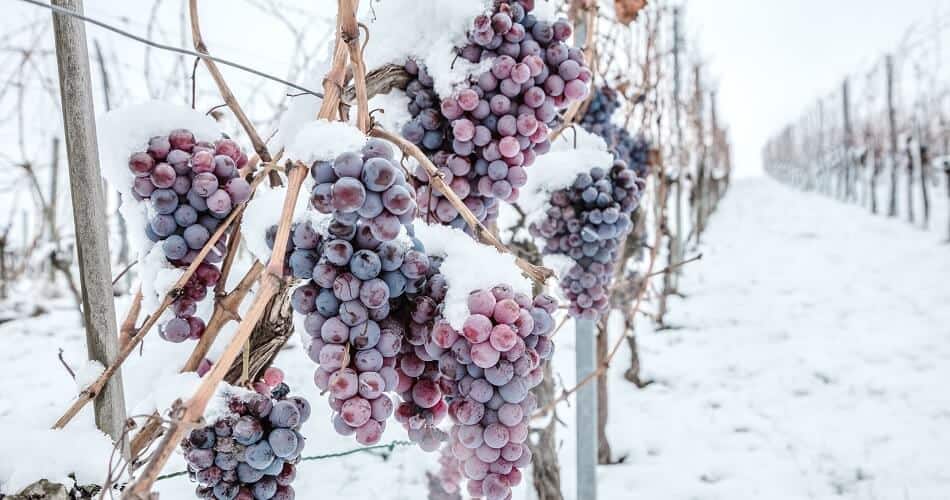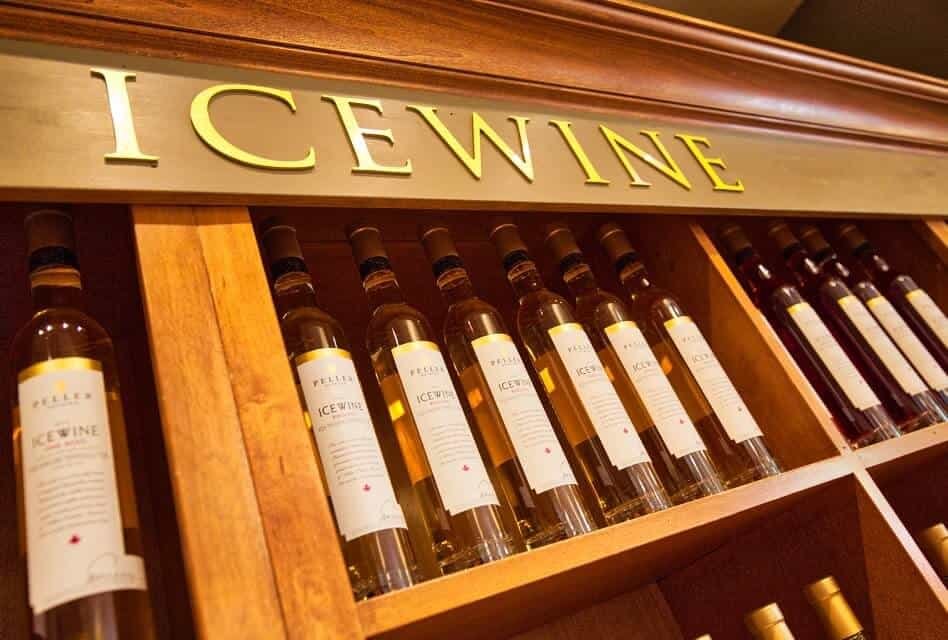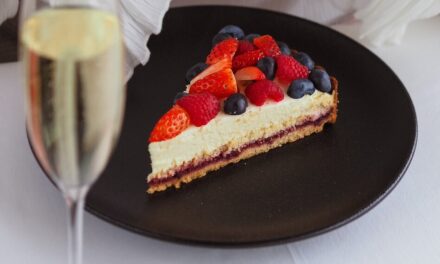Ice wine is a very sweet type of dessert wine that is made from frozen red or white grapes. As very specific conditions are needed to produce it, it’s rare and also expensive in most parts of the world.
The sweet frozen wine has a fascinating history. And the production methods that vintners follow to make it are still unique. In this article, we will cover both topics in detail, and we will also talk about the best ways to enjoy ice wine.
WHAT IS ICE WINE MADE FROM?
Winemakers use regular wine grapes to produce ice wine. Both red and white varietals are eligible for this purpose.
German vintners make great whites from Riesling grapes, while Canadians produce delicious wines from Vidal grapes. But they also use many other varietals, including Gewürztraminer, Chardonnay, or Sauvignon Blanc.
Red varietals that make good ice wines are -among others- Merlot, Cabernet Franc, Pinot Noir, and Malbec.
HOW ICE WINE IS MADE
The process of producing ice wine differs in multiple aspects from making red or white table wine.
The harvest season for table wine usually starts between the middle of September and early November. But grapes for ice wine stay on the vines until the winter when temperatures drop to at least 20°F (-7°C). With temperatures that low, the water inside the grapes freezes. Only a small portion of juice remains liquid, and the grape’s sugar content concentrates on this juice.

Frozen Grapes on a Vineyard
Vintners often harvest the frozen grapes in the middle of the night and press them in unheated rooms to extract their sugar-rich liquid. As the frozen water remains in the fruit, each grape yields only 10 to 20% of the amount of must that vintners can extract from a non-frozen grape. This must, however, is highly concentrated and contains a lot of sugar.
The fermentation process also takes longer than it does for table wine. It must happen at low temperatures to preserve the freshness of the must. Because of these low temperatures and the high sugar content of the must, fermentation takes three to six months. In comparison, table wines typically ferment for only two weeks.
Most ice wines don’t undergo an aging process after fermentation. There are exceptions, though: Some North American wines age in oak barrels for several months to develop their complex aromas.
As the traditional way to make ice wine is a time-consuming and costly process, some winemakers prefer to take shortcuts. Instead of waiting for the right temperatures to freeze grapes naturally, they harvest them and freeze them artificially. While this method is easier and less expensive, it isn’t permitted if vintners want to use the label “ice wine”.
WHERE DID ICE WINE ORIGINATE?
It’s believed that winemakers in the German region of Franconia accidentally invented ice wine (or “Eiswein”, its German name) in the late 18th century. A sudden onset of winter froze their harvest before they got the chance to bring it in. Unwilling to waive their yield, they picked and pressed the grapes anyway and were stunned by the amazingly sweet outcome.
Since then, German vintners produced ice wines occasionally in the following decades whenever the weather allowed it. As winters tended to be too mild to freeze grapes, they did not put too much effort into producing them.
Nowadays, winemakers in Rheinhessen and other German wine regions rely on highly professionalized production processes and strict supervision to create high-quality ice wines. These wines, typically made from Riesling grapes, are classified as “Prädikatsweine” – a label awarded only to the best German wines.
But other countries produce sweet dessert wine as well. Immigrants from Germany brought their traditions to Canada in the 1970s. In Ontario and British Columbia, they faced ideal conditions and leveraged them to make Canada the leading country in production volume. Today, Vidal ice wines from Ontario are among the best in the world. Other important producers are Austria, the United States, and New Zealand.
WHAT DOES ICE WINE TASTE LIKE?
Ice wines are, by nature, very sweet but also high in acidity. This excellent balance often combines with bright and fresh floral and fruity aromas. Their alcohol content is usually rather low: Expect between 6% and 13%, with German Rieslings at the lower end and Canadian Vidal wines at the upper end of the range.
White styles typically are full-bodied and offer flavors of honey, peach, citrus, mango, or other tropical fruits. Reds are a little lighter but also sweeter than whites. They offer aromas like dried figs, cherry, pomegranate, or red berries. Oak-aged types add nutty nuances to their bouquet.
HOW TO SERVE ICE WINE
Ice wine is great pure with or instead of dessert. But you can also mix it into ice wine cocktails. In any case, you should create the perfect conditions in terms of serving temperature and aeration. Also, make sure to use the right glasses.
What Is the Right Glass for Ice Wine?
You might consider serving ice wine in dessert wine glasses (also called aperitif glasses). These glasses are small in size, with a volume of about 4 ounces (120 milliliters) to make it easier to serve proper portions. They are not the best match, though. You better go with tulip-shaped white wine glasses. They provide more room to breathe and allow you to swirl the wine properly before tasting. Fill them with portions of 1.5 to 2 ounces of ice wine (45 to 60 ml).
What Is the Right Serving Temperature for Ice Wine?
Ice wine should be served chilled but not freezing. Temperatures between 43 and 50°F (6-10°C) are fine. To cool it down properly, place it in the refrigerator for about one hour. Additionally, you can chill the glasses in the fridge for 10 to 15 minutes before pouring the wine in.
Should You Decant Ice Wine?
Ice wines do not need decanting. They are complex, and oxygen helps them show their full potential. So decanting seems to be a logical step. However, you should not do so. They would simply get too warm too quickly. Better pour them into glasses immediately after opening the bottle and swirl them for a couple of seconds to get them in touch with oxygen.
HOW TO STORE ICE WINE
If you plan to store ice wine longer than a couple of days, make sure to provide optimal cellar conditions: It needs a constant, cool temperature of about 54 to 59°F (12-15°C). Lay the bottle on its side to prevent the cork from drying out. Otherwise, air could get in and oxidize and finally ruin the wine.
Can Ice Wine Be Aged?
Some types are age-worthy, but not all of them. Their ability to gain complexity depends on their balance: The deciding factor for developing more depth and a wider range of aromas is a good acidity to balance the sweetness.
Here is a list of wines ordered by their age-worthiness:
- Riesling and Grüner Veltliner wines are the best picks for cellaring. You can store them for decades while they constantly get better and develop aromas of maple or hazelnut.
- You can age Vidal for five to seven years.
- Gewürztraminer should not be cellared longer than three to five years.
- Chardonnay, Cabernet Franc, and Merlot dessert wines have only little aging potential. Consume them while they are young and crisp.
Be aware that all types will lose some of their sweetness when you age them.
Can Ice Wine Go Bad?
Ice wine can go bad. Like any other wine, exposure to oxygen in combination with high temperatures can cause it to spoil over time. If it smells like vinegar, the chances are high that it isn’t drinkable anymore.
How Long Does Ice Wine Last When Open?
As ice wine contains a lot of residual sugar that functions as a preservative, it lasts quite long in comparison to most table wines. An open bottle can last several weeks, in theory, given that you reseal it and keep it in the refrigerator. However, with each day of storing, the chance of spoiling rises. Better enjoy it within 3 to 5 days after opening than take this risk.
ICE WINE AND FOOD PAIRING
Because of its sweetness, ice wine is a great wine to enjoy with your dessert. But it also goes well with some appetizers and even some main dishes.
Rich Foods
Wines with good acidity are good matches for thick fatty meats like duck or goose and for specialties like liver pate (for instance, foie gras). But they are also great to pair fatty seafood like eel.
Spicy Dishes
The icy dessert wine tastes great with spicy foods from Mexican, Thai, Indian, or Cajun cuisine. The wine’s sweetness balances the spices, and when served properly chilled, it also counters the heat in your mouth pleasantly.
Salty Snacks
Another great match for sweet types is salty food. Combine them with anchovies, capers, or oysters or with snacks like olives or salty crackers.
Sweet Desserts
Ice wine belongs to the category of dessert wines, so, logically, you can pair it with many desserts. In general, you should go for a dessert that is a bit less sweet and lighter than the wine.
White types go well with fruity desserts, especially with stone fruits like peaches or nectarines. But their fruity flavors also match superbly with creamy dishes like crème brûlées, cheesecake, or custard.
Reds, mainly Cabernet Franc wines, are fantastic with chocolate-based dishes like chocolate mousse or chocolate cakes.
Cheese
Combining ice wine with cheese is another way to create a greatly balanced sensation of sweetness and salty or spicy flavors. The cheese of your choice should not be too mild, though. Otherwise, the wine’s intense, sweet taste will overpower it. Here are some great combinations:
- Soft cheeses: Brie, goat cheese
- Salty hard cheeses: Gruyère, Parmigiano-Reggiano (also known as Parmesan)
- Piquant blue cheeses: Gorgonzola, Roquefort, Stilton
SHOPPING ICE WINE
When shopping for ice wine, you should pay special attention to its label. According to U.S. wine laws, “ice wine” is a protected product name. The same is true for “Icewine” in Canada and “Eiswein” in Germany and Austria. Only wines made from grapes that were harvested while frozen naturally can carry this label.
Wines from artificially frozen grapes typically go by names such as “iced wine”, “dessert wine”, or a combination of the varietal name and “ice” or “iced”. These types are less expensive but also lack the quality of the original.
How Much Does Ice Wine Cost?
Typically, ice wine comes in bottles of 375ml and starts from $30. If you find much cheaper wines, they were probably made from artificially frozen grapes. The best and most complex wines can cost up to $100 per bottle.
Especially American wines are often available in smaller packages of 200 ml or even less, though. So when you are starting to discover the world of frozen dessert wines, consider these smaller bottles to learn which styles you like best.
The following wines are worth trying:
Inniskillin Vidal Icewine 2019
- type: white, dessert wine, Vintage
- origin: Canada, Ontario
- varietal: Vidal
- alcohol: 9.5%
- type: white, dessert wine, Vintage
- origin: USA, New Jersey
- varietal: Vidal
- alcohol: 12.5%
Inniskillin Cabernet Franc Icewine 2019
- type: red, dessert wine, Vintage
- origin: Canada, Ontario
- varietal: Cabernet France
- alcohol: 9.5%

Inniskillin Vidal Icewine 2019
$61.99
from: Wine.com
FINAL WORDS
Beyond all doubts, ice wine is an extraordinarily delicious experience and a great drink to round off a fabulous dinner night. Even if you prefer dry table wines, you should give its sweet sensation a try – it might convert you into a frozen grapes lover.






